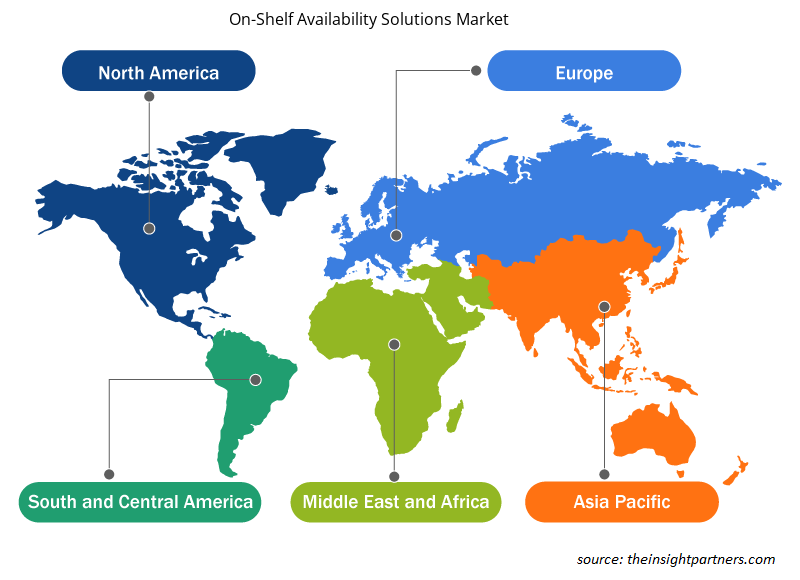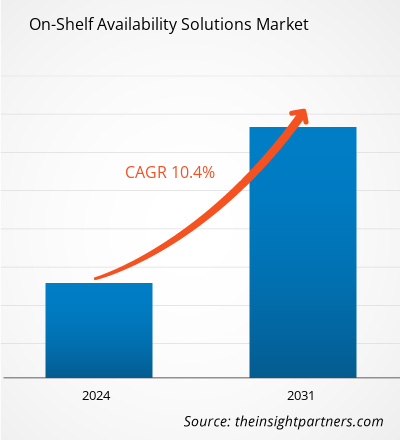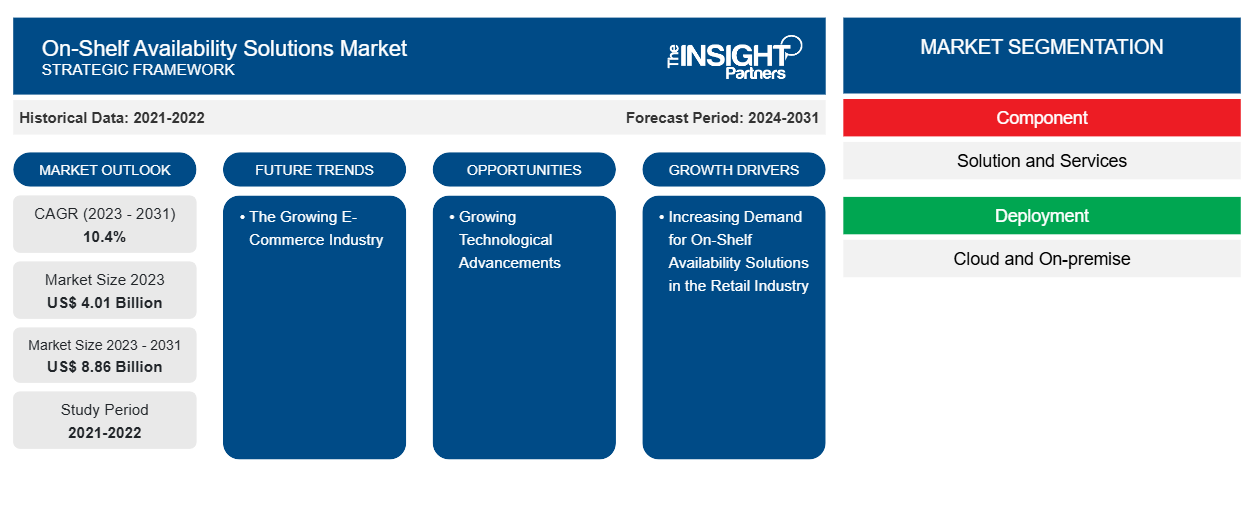预计到 2031 年,货架可用性解决方案市场规模将从 2023 年的 40.1 亿美元增至 88.6 亿美元。预计 2023-2031 年该市场的复合年增长率将达到 10.4%。电子商务行业的蓬勃发展很可能仍是货架可用性解决方案市场的一个关键趋势。
现货供应解决方案市场分析
全球零售店数量的不断增长,推动了零售行业对货架可用性解决方案的需求,这是推动市场增长的主要因素之一。此外,对全渠道解决方案的需求不断增长以及对客户体验的日益关注正在推动市场的增长。此外,人工智能、机器学习、计算机视觉等先进技术的日益融合为未来几年货架可用性解决方案市场的增长创造了机会。
现货供应解决方案市场概览
货架可用性是指顾客到店购买商品时,商品是否在货架上。货架可用性可确保顾客可以轻松无忧地购买所需的商品。对于零售商而言,这可确保消费者满意,并增加产品销售收入。货架可用性也有助于制造商,因为它可保证商品销售,并为库存控制提供有用信息。因此,在零售行业,货架可用性是必须有效监控和维护的关键因素。
定制此报告以满足您的需求
您可以免费定制任何报告,包括本报告的部分内容、国家级分析、Excel 数据包,以及为初创企业和大学提供优惠和折扣
-
获取此报告的关键市场趋势。这个免费样品将包括数据分析,从市场趋势到估计和预测。
现货供应解决方案市场驱动因素和机遇
零售行业对货架可用性解决方案的需求不断增加
商店运营的基本原则仍然是许多零售商面临的挑战,通常是因为他们无法解释他们拥有的数据,或者无法获得改进所需的信息。为了解决这个问题,零售商正在采用货架可用性解决方案。该解决方案可以帮助零售商提供客户满意度并通过销售产品增加收入。此外,它还有助于零售商提高品牌声誉并培养更积极的公司文化。因此,所有上述因素都在增加零售行业对货架可用性解决方案的需求,推动市场的增长。
不断进步的技术
手动货架管理需要高昂的人力成本,而且大多以规定的频率进行。为了解决这个问题,各种市场参与者都在不断致力于整合人工智能、计算机视觉等先进技术。集成这些技术可以通过使用价格标签识别、产品识别、OOS 检测、活动识别和光学字符识别 (OCR) 等算法对货架物品进行识别、分类和盘点,自动帮助检测 OOS 物品、错误放置和其他问题。因此,此类技术进步可以在预测期内为市场增长创造机会。
货架可用性解决方案市场报告细分分析
有助于得出现货可用性解决方案市场分析的关键部分是组件、部署和最终用户。
- 根据组件,市场分为解决方案和服务。解决方案部分在 2023 年占据了更大的市场份额。
- 根据部署,市场分为云和本地。云部分在 2023 年占据了最大的市场份额。
- 根据最终用户,市场分为 CPG 制造商、零售商、供应商和其他。CPG 制造商部门在 2023 年占据了最大的市场份额。
按地区划分的现货可用性解决方案市场份额分析
现货可用性解决方案市场报告的地理范围主要分为五个地区:北美、亚太地区、欧洲、中东和非洲、南美/南美和中美。
就收入而言,北美占据了货架可用性解决方案的最大市场份额。该地区的市场分为美国、加拿大和墨西哥。该地区的电子商务行业正在经历巨大的增长,这是推动市场增长的主要因素之一。此外,该地区的零售和供应链行业高度发达,这进一步促进了北美对货架可用性解决方案的需求增长。
现货供应解决方案市场区域洞察
Insight Partners 的分析师已详尽解释了预测期内影响货架可用性解决方案市场的区域趋势和因素。本节还讨论了货架可用性解决方案市场的各个部分和地理位置,包括北美、欧洲、亚太地区、中东和非洲以及南美和中美洲。

- 获取货架可用性解决方案市场的区域特定数据
现货可用性解决方案市场报告范围
| 报告属性 | 细节 |
|---|---|
| 2023 年的市场规模 | 40.1亿美元 |
| 2031 年市场规模 | 88.6亿美元 |
| 全球复合年增长率(2023 - 2031) | 10.4% |
| 史料 | 2021-2022 |
| 预测期 | 2024-2031 |
| 涵盖的领域 |
按组件
|
| 覆盖地区和国家 |
北美
|
| 市场领导者和主要公司简介 |
|
货架可用性解决方案市场参与者密度:了解其对业务动态的影响
货架可用性解决方案市场正在快速增长,这得益于最终用户需求的不断增长,这些需求源于消费者偏好的不断变化、技术进步以及对产品优势的认识不断提高等因素。随着需求的增加,企业正在扩大其产品范围,进行创新以满足消费者的需求,并利用新兴趋势,从而进一步推动市场增长。
市场参与者密度是指在特定市场或行业内运营的企业或公司的分布情况。它表明相对于给定市场空间的规模或总市场价值,有多少竞争对手(市场参与者)存在于该市场空间中。
在现货可用性解决方案市场运营的主要公司有:
- 阿特拉斯科技集团
- BeMyEye 控股有限公司
- IBM 公司
- 零售解决方案
- 公司
- 思爱普
免责声明:上面列出的公司没有按照任何特定顺序排列。

- 获取货架可用性解决方案市场顶级关键参与者概览
现货供应解决方案市场新闻和最新发展
通过收集主要和次要研究后的定性和定量数据来评估货架可用性解决方案市场,其中包括重要的公司出版物、协会数据和数据库。以下是言语和语言障碍市场的发展和策略列表:
- Retail Velocity 是消费者需求和供应数据管理、报告和分析领域的先驱和行业领导者,该公司宣布推出其第 10 代 VELOCITY 平台并推出 VELOCITY Essential。这款新的 VELOCITY Pro 10 提供了更高的性能、更轻松的数据管理、增强的报告和额外的安全性,使消费品制造商能够比以往更快地获得更深入的可行洞察;在内部和与零售商合作伙伴之间做出更明智的协作决策;并快速有效地应对不断变化的消费者需求和市场条件。(来源:Retail Velocity,新闻稿,2022 年)
- 领先的数据科学和 AI 工程公司 Tredence Inc. 宣布与统一分析领域的领导者 Databricks 建立合作伙伴关系,Databricks 由 Apache Spark 的原始创建者创立。在此次合作下,两家公司联合打造了货架可用性解决方案 (OSA) 加速器,通过结合 Databricks 的数据处理能力和 Tredence 在 AI/ML 方面的专业知识,帮助零售商和制造商解决缺货问题。(来源:Tredence Inc,新闻稿,2021 年)
现货供应解决方案市场报告覆盖范围和交付成果
“现货可用性解决方案市场规模和预测(2021-2031)”报告对市场进行了详细分析,涵盖以下领域:
- 范围内所有主要细分市场的全球、区域和国家层面的市场规模和预测
- 市场动态,如驱动因素、限制因素和关键机遇
- 未来的主要趋势
- 详细的 PEST/波特五力分析和 SWOT 分析
- 全球和区域市场分析涵盖关键市场趋势、主要参与者、法规和最新市场发展
- 行业格局和竞争分析,涵盖市场集中度、热点图分析、知名参与者和最新发展
- 详细的公司简介
- 历史分析(2 年)、基准年、预测(7 年)及复合年增长率
- PEST和SWOT分析
- 市场规模、价值/数量 - 全球、区域、国家
- 行业和竞争格局
- Excel 数据集
近期报告
客户评价
购买理由
- 明智的决策
- 了解市场动态
- 竞争分析
- 客户洞察
- 市场预测
- 风险规避
- 战略规划
- 投资论证
- 识别新兴市场
- 优化营销策略
- 提升运营效率
- 顺应监管趋势























 获取免费样品 - 货架可用性解决方案市场
获取免费样品 - 货架可用性解决方案市场